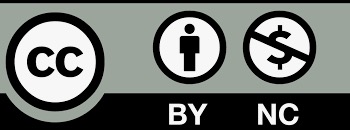Published
2024-08-15
Section
Research Articles
License
The journal adopts the Attribution-NonCommercial 4.0 International (CC BY-NC 4.0), which means that anyone can reuse and redistribute the materials for non-commercial purposes as long as you follow the license terms and the original source is properly cited.
Author(s) shall retain the copyright of their work and grant the Journal/Publisher rights for the first publication with the work concurrently licensed since 2023 Vol.8 No.2.
Under this license, author(s) will allow third parties to download, reuse, reprint, modify, distribute and/or copy the content under the condition that the authors are given credit. No permission is required from the authors or the publisher.
This broad license intends to facilitate free access, as well as the unrestricted use of original works of all types. This ensures that the published work is freely and openly available in perpetuity.
By providing open access, the following benefits are brought about:
- Higher Visibility, Availability and Citations-free and unlimited accessibility of the publication over the internet without any restrictions increases citation of the article.
- Ease of search-publications are easily searchable in search engines and indexing databases.
- Rapid Publication – accepted papers are immediately published online.
- Available for free download immediately after publication at https://esp.as-pub.com/index.php/ESP

Copyright Statement
1.The authors certify that the submitted manuscripts are original works, do not infringe the rights of others, are free from academic misconduct and confidentiality issues, and that there are no disputes over the authorship scheme of the collaborative articles. In case of infringement, academic misconduct and confidentiality issues, as well as disputes over the authorship scheme, all responsibilities will be borne by the authors.
2. The author agrees to grant the Editorial Office of Environment and Social Psychology a licence to use the reproduction right, distribution right, information network dissemination right, performance right, translation right, and compilation right of the submitted manuscript, including the work as a whole, as well as the diagrams, tables, abstracts, and any other parts that can be extracted from the work and used in accordance with the characteristics of the journal. The Editorial Board of Environment and Social Psychology has the right to use and sub-licence the above mentioned works for wide dissemination in print, electronic and online versions, and, in accordance with the characteristics of the periodical, for the period of legal protection of the property right of the copyright in the work, and for the territorial scope of the work throughout the world.
3. The authors are entitled to the copyright of their works under the relevant laws of Singapore, provided that they do not exercise their rights in a manner prejudicial to the interests of the Journal.
About Licence
Environment and Social Psychology is an open access journal and all published work is available under the Creative Commons Licence, Authors shall retain copyright of their work and grant the journal/publisher the right of first publication, and their work shall be licensed under the Attribution-NonCommercial 4.0 International (CC BY-NC 4.0).
Under this licence, the author grants permission to third parties to download, reuse, reprint, modify, distribute and/or copy the content with attribution to the author. No permission from the author or publisher is required.
This broad licence is intended to facilitate free access to and unrestricted use of original works of all kinds. This ensures that published works remain free and accessible in perpetuity. Submitted manuscripts, once accepted, are immediately available to the public and permanently accessible free of charge on the journal’s official website (https://esp.as-pub.com/index.php/ESP). Allowing users to read, download, copy, print, search for or link to the full text of the article, or use it for other legal purposes. However, the use of the work must retain the author's signature, be limited to non-commercial purposes, and not be interpretative.
Click to download <Agreement on the Licence for the Use of Copyright on Environmental and Social Psychology>.
How to Cite
Comparison of novel character relationship network mining and drama character relationship shaping algorithms
yang Xiang
College of Arts and Sciences, Universiti Utara Malaysia, UUM Sintok Kedah Darul Aman
Ahmad Hisham Bin Zainal Abidin
College of Arts and Sciences, Universiti Utara Malaysia, UUM Sintok Kedah Darul Aman
DOI: https://doi.org/10.59429/esp.v9i7.2076
Keywords: novel character relationship, NLP, machine learning, sentiment analysis, network mining, precision, recall, F-score, accuracy
Abstract
This study embarks on an interdisciplinary journey to analyze and compare Character Relationships (CR) in two diverse storytelling mediums – the classic novel “Emma” by Jane Austen and the popular TV series “Friends”. Leveraging a blend of Natural Language Processing (NLP) and advanced video analysis tools, this research “sheds light on” the intricate network of CR within these narratives. This study scientifically analyzes these relationships' complete method, creation, and impact using sentiment analysis, object identification, and story coherence algorithms. Qualitative and quantitative metrics such as precision, recall, F-score, and accuracy assist in explaining character updates. The content and TV exhibit distinct storytelling modes, and this study demonstrates that algorithmic analysis of stories is practical. The findings of this study request to contribute to online studies by focusing on understanding character networks and their vital role in TV storytelling.
References
[1]. Andreescu, R., & Dimitriu, A. (Eds.). (2021). Handbook of Research on Contemporary Storytelling Methods Across New Media and Disciplines. IGI Global.
[2]. Gailea, N. (2023). Studies in drama. Cv. Azka pustaka.
[3]. Liu, S., Nie, W., Wang, C., Lu, J., Qiao, Z., Liu, L., ... & Anandkumar, A. (2023). Multi-modal molecule structure–text model for text-based retrieval and editing. Nature Machine Intelligence, 5(12), 1447-1457.
[4]. Li, J., & Engelbrecht, A. (2024). Advances in Sentiment Analysis: Techniques, Applications, and Challenges.
[5]. Jugran, s., kumar, a., tyagi, b. S., & Anand, V. (2021, March). Extractive automatic text summarization using SpaCy in Python & NLP. In 2021 International Conference on Advanced Computing and Innovative Technologies in Engineering (ICACITE) (pp. 582-585). IEEE.
[6]. Kolluru, K., Adlakha, V., Aggarwal, S., & Chakrabarti, S. (2020). Openie6: Iterative grid labelling and coordination analysis for open information extraction. arXiv preprint arXiv:2010.03147.
[7]. Wajahat, A., Nazir, A., Akhtar, F., Qureshi, S., Razaque, F., & Shakeel, A. (2020, January). Interactively visualize and analyze the social network Gephi. In 2020 3rd International Conference on Computing, Mathematics and Engineering Technologies (iCoMET) (pp. 1- IEEE.
[8]. Vaswani A, Shazeer N, Parmar N, Uszkoreit J, Jones L, Gomez AN, Kaiser Ł, Polosukhin I. Attention is all you need: Advances in neural information processing systems 2017; 30.
[9]. Pennington J, Socher R, Manning CD. Glove: global vectors for word representation. In: Proceedings of the 2014 conference on empirical methods in natural language processing, 2014; 1532–1543.
[10]. L Akritidis, P Bozanis, “Low-Dimensional Text Representations for Sentiment Analysis NLP Tasks”, SN Computer Science 4 (5), 474.Mikolov T, Chen K, Corrado G, Dean J. Efficient estimation of word representations in vector space. arXiv preprint arXiv:1301.3781 2013.
[11]. Kusner M, Sun Y, Kolkin N, Weinberger K. From word embeddings to document distances. In: Proceedings of the 32nd international conference on machine learning, 2015; 957–966.
[12]. M. Nijila and M. T. Kala, "Extraction of Relationship Between Characters in Narrative Summaries," 2018 International Conference on Emerging Trends and Innovations In Engineering And Technological Research (ICETIETR), Ernakulam, India, 2018, pp. 1-5, doi: 10.1109/ICETIETR.2018.8529125.
[13]. A. I. Rathnayake, I. Kumari Ganegala, I. S. Samarasinghe, S. Bandara Weerasekara, A. I. Gamage and T. Thilakarathna, "Adjusting The Hard Level on Game by a Prediction for Improving Attraction and Business Value," 2020 20th International Conference on Advances in ICT for Emerging Regions (ICTer), Colombo, Sri Lanka, 2020, pp. 310-311, doi: 10.1109/ICTer51097.2020.9325474.
[14]. Xiaoxuan Chen and C. Qi, "A super-resolution method for recognition of license plate character using LBP and RBF," 2011 IEEE International Workshop on Machine Learning for Signal Processing, Beijing, China, 2011, pp. 1-5, doi: 10.1109/MLSP.2011.6064550.
[15]. M. Park, S. Park and H. Shin, "Literature Representation using Character Networks based on Sentiment Analysis," 2022 IEEE International Conference on Big Data and Smart Computing (BigComp), Daegu, Korea, Republic of, 2022, pp. 190-193, doi: 10.1109/BigComp54360.2022.00044.







